In this article:
The Achilles tendon is a fibrous chord made of connective tissue that links your heel bone to the muscles at the back of your calf.
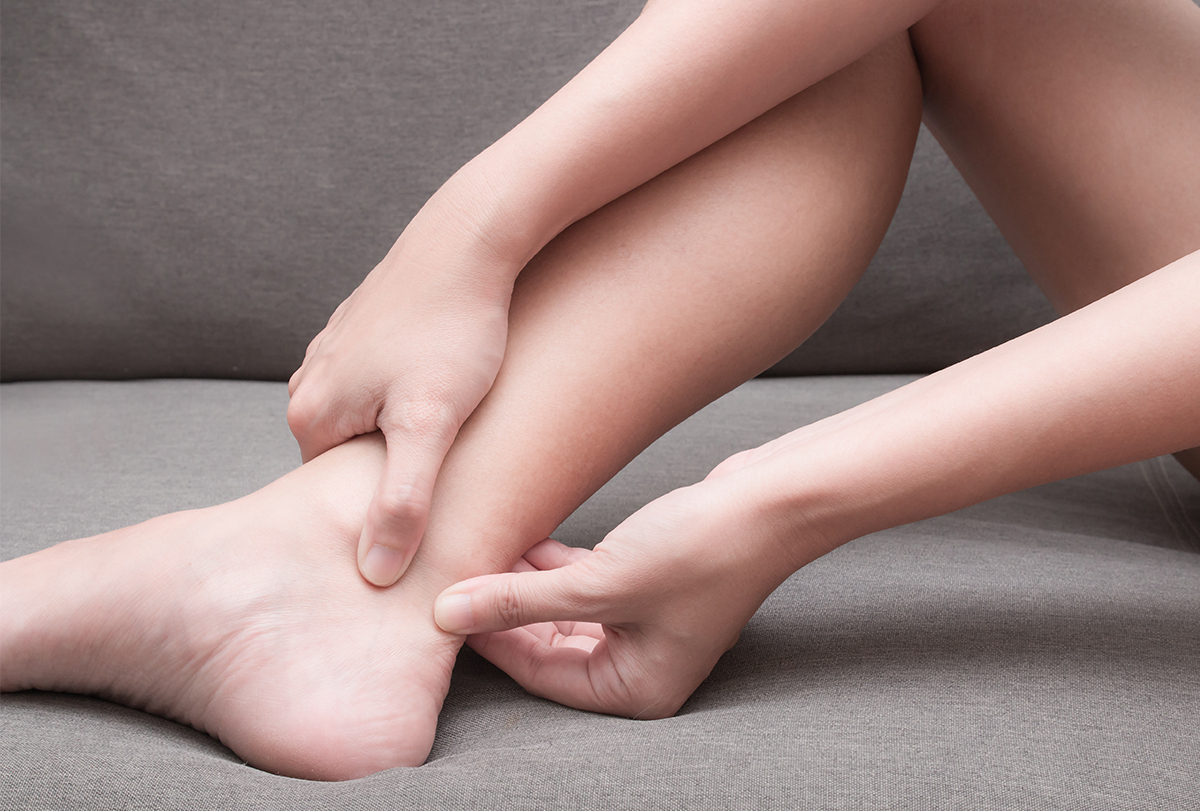
Being the largest and strongest tendon in the body, the Achilles tendon forms the nucleus around which a complex system of 26 bones, 33 joints, and over 100 tendons, ligaments, and muscles work in symphony to enable you to stand on your feet.
Given that most of your waking hours are spent standing up, the Achilles tendon tends to bear the brunt of your body weight. The damage is only made worse by hyperactive lifestyles.
Any sudden jolt or exertion further debilitates the tendon, causing it to be inflamed or injured. This condition that results from the sudden or gradual degradation of the Achilles tendon is referred to as Achilles tendinitis (also spelled tendinitis).
What Causes Achilles Tendinitis?
- Tendinitis due to repeated stress to the Achilles tendon causing it to wear out is most common among younger and middle-aged people who participate in sports such as running, gymnastics, dance, football, baseball, softball, basketball, tennis, and volleyball. Both professional and amateur athletes, as well as non-athletes, can fall victim to this condition. (1)
- This problem can occur due to a sudden spurt in the amount or intensity of physical activity, without allowing your body time to adjust to the abrupt and added labor.
- Not stretching properly before exercising, running on hard surfaces, and doing lots of jumping can damage the tendon of a person with tight calf muscles, especially when done without a proper warmup. (1)
- It can also be caused by wearing high heels for extended hours and not wearing shoes with proper support. Certain factors make you predisposed to developing this condition, including flat feet, obesity, diabetes, or high blood pressure, and taking certain types of antibiotics. (2)
- People with excessive pronation or flatness of the arch are at a greater risk of developing this problem because of the increased demands placed on the tendon while walking. It is, therefore, essential that they take proper precautions and wear customized shoes with adequate stability.
- People engaged in labor-intensive work on a regular basis and individuals who engage in intense physical activities but in an infrequent manner are both vulnerable to tendinitis – the former due to excessive physical strain and the latter due to inadequate conditioning to physical strain.
What Are the Signs and Symptoms of Tendinitis?
The main signs and symptoms of Achilles tendinitis are:
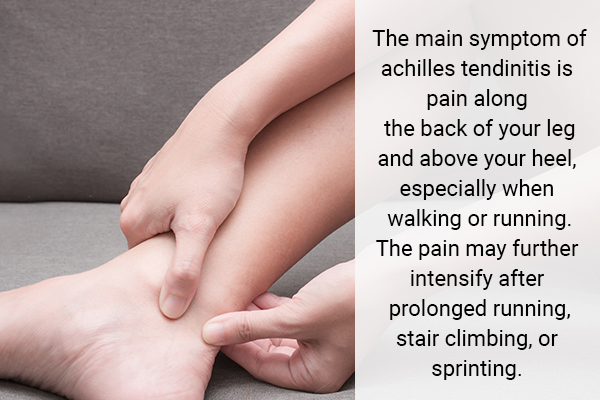
- Pain along the back of your leg and above your heel, especially when walking or running. (2) The pain may further intensify after prolonged running, stair climbing, or sprinting.
- Bruising and swelling.
- Tenderness when touched.
- Stiff muscles and difficulty standing or walking. (2)
- At an advanced stage of degeneration, the tendon may become enlarged and sprout nodules where the tissue is damaged.
How Is Achilles Tendinitis Medically Treated?
The doctor may order tests such as an X-ray of the foot or MRI scan of the tendon to rule out the possibility of fractures and partial tears as well as occasional blood tests to rule out any underlying inflammatory condition.
The preliminary treatment for mild cases of tendinitis requires you to rest the affected foot by avoiding any strenuous activity that might worsen the damage. Your doctor will ask you to go easy on your leg and feet for as long as it takes for your tendon to fully repair itself, which can vary anywhere between weeks and months.
Over-the-counter NSAIDs such as ibuprofen can help manage the acute pain and swelling during the initial stages, along with applying ice packs and compresses.
Moreover, your podiatrist might prescribe orthotic inserts for your shoes to take the pressure off the tendon as it recovers. Orthotic shoe devices are especially recommended for people with flat or hyperpronated feet as a long-term intervention.
In severe cases that involve a torn or ruptured tendon, your foot may be placed in a cast, splint, brace, or restrictive ankle boot to minimize movement of the lower leg and ankle to allow the tendon enough time to heal. Moreover, surgery may be recommended, especially in younger, active individuals.
Once the initial phase of acute inflammation has resolved to a bearable degree, your physiotherapist will recommend certain customized exercises to gently stretch the calf muscles. Due to continued immobility, the affected area tends to become tense and prone to more injuries.
Stretching exercises will help you retain the flexibility and strength of your muscles, tendons, and ligaments, aid in recovery, and prevent future injuries. Surgery serves as the last resort in extreme cases when the damage is too severe to be repaired by other methods of therapy.
Surgery for tendinosis is debridement, whereas surgery for rupture involves the repair of the torn ends back to each other. However, rest assured that most cases of Achilles tendinitis resolve on their own with sufficient rest and minor treatment.
How Is Achilles Tendinitis Diagnosed?
If you suspect that your Achilles tendon has been injured, it’s best to get it checked out by a doctor before it gets aggravated. In order to reach a conclusive diagnosis, your doctor will:
- Inquire about your medical history, routine physical activities, exercise habits, and choice of footwear.
- Physically examine your leg, foot, ankle, and knee for range of motion and to gauge the thickness and tenderness of the Achilles tendon.
- Check to see if your tendon hasn’t ruptured by relaxing your leg and squeezing your calf to make sure that your tendon moves your foot.
Tips and Home Remedies to Get Relief From Achilles Tendinitis
Here are some home remedies to help you recover from Achilles tendinitis naturally.
1. Take proper rest
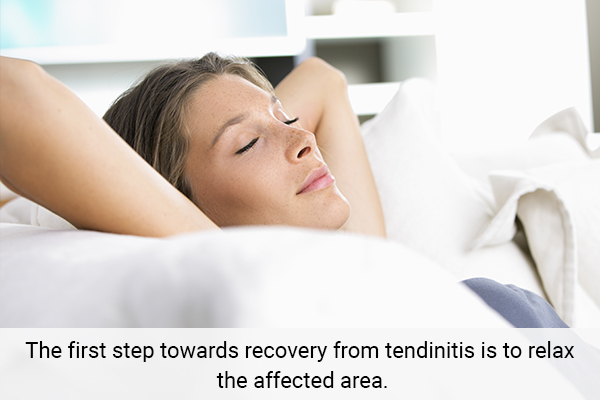
The first step towards recovery from tendinitis is to relax the affected area. To prevent the pain from worsening, it is imperative to put a hold on any activity that may induce further damage to an already overworked tendon.
If you regularly do high-impact exercises (such as running), switching to low-impact activities will put less stress on the Achilles tendon.
Cross-training activities such as biking, elliptical exercise, and swimming are low-impact options to help you stay active without causing undue strain to the Achilles tendon. (3)
2. Apply cold compress
A cold compress helps alleviate two of the main symptoms associated with tendinitis, namely, pain and swelling. (4)
The mechanism at play here is that ice helps numb the pain and causes the blood vessels to constrict, thereby reducing the swelling. Furthermore, this cold therapy is effective in relaxing the affected muscles, which, in turn, helps to relieve pain.
How to use:
- Put a few ice cubes in a thin towel and tie it securely.
- Apply this ice pack to the affected area for 10 to 15 minutes.
- Then, remove the pack for the next 15 minutes to avoid any skin damage.
- Repeat this several times a day.
- In case the ice pack feels too cold, you can use a bag of frozen peas or a washcloth soaked in cold water instead.
Note: Do not apply ice directly on the skin as it may cause frostbite.
3. Perform eccentric exercises
It is recommended that patients should undergo an eccentric exercise program prior to considering other treatments such as surgery. (5) Eccentric exercises focus on stretching and lengthening the muscle-tendon unit as opposed to concentric exercise that contract it.
Current literature regarding Achilles tendinitis suggests that eccentric exercises are useful in the treatment of pain and the restoration of function. There are numerous potential explanations supporting the rationale for the effectiveness of eccentric regimes; however, many of the suggested explanations have not been fully investigated. (6)
An eccentric strengthening protocol (3) is defined as flexing or tightening the muscle while it is getting longer. These exercises require initial supervision as they can cause damage to the Achilles tendon if not done correctly.
Thus, it is well advised to get the guidance of a physical therapist when you are just starting out with this regimen. Once mastered with a therapist, the exercises can then be done at home independently.
These exercises are likely to cause some discomfort but it is well within the degree of tolerance and well worth the results.
a. Bilateral heel drop
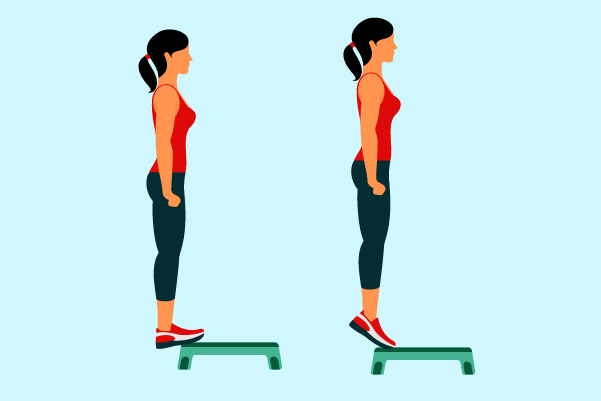
Stand at the edge of a stair, or any other elevated platform that is stable, with just the front half of your foot on the stair such that you are free to move your heel up and down without hitting the stair. Hold on to the railing to help you balance your body weight.
Lift your heels off the ground, and then gradually lower your heels to the lowest point possible. Repeat this step 20 times. This exercise should not be rushed and done in a composed and controlled fashion. Rapid movement can jolt the tendon into further damage.
Over time, as the pain improves, you can increase the difficulty level of the exercise by holding a small weight in each hand.
b. Single-leg heel drop
This exercise is along the lines of the bilateral heel drop except that all your weight is focused on one leg. You should pursue this exercise only once you have mastered the bilateral heel drop.
4. Use warm wraps or elastic bandages
After the first 3 days of ice therapy, it is advisable to switch to warm compresses for the relief of chronic tendinitis pain. Applying heat increases blood flow to the aggrieved area, which helps promote healing. Heat also relaxes the strained calf muscles, which causes the pain to subside. (7)
You can use warm wraps or compressive elastic bandages to reduce the amount of stress placed on the affected muscles. These wraps are readily available at regular drugstores, and you can even consult your doctor regarding which type of wrap will work best for your condition. (8)
How to use:
- Wrap your foot and lower leg with an elastic bandage or compression wrap.
- To optimize results, try to keep your leg elevated, which helps with the swelling.
- Keep the area wrapped for a few days or until you get relief from the swelling and soreness.
Note: Avoid wrapping too tightly, which can lead to poor circulation, and be sure to loosen the wrap if you feel increased pain or experience other symptoms.
5. Massage the affected area
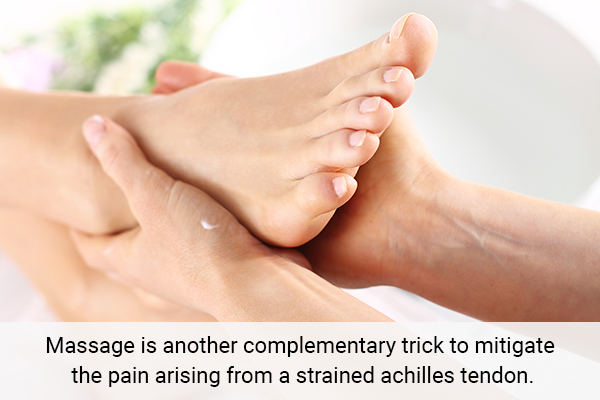
Massage is another complementary trick to mitigate the pain arising from a strained Achilles tendon. (9) A gentle massage helps increase circulation, loosen the muscles, and reduce the swelling and stiffness in the calf area. For the massage, you can use olive, coconut, sesame, or mustard oil.
- Slightly warm some oil of your choice.
- Using your fingers, gently massage the lower part of your foot and heel with the oil for 10 to 15 minutes.
- Repeat this massage a few times daily until the pain subsides.
Note: If you have trouble reaching the affected area without further discomfort, you can enlist the help of a friend or a professional massage therapist to do it for you.
6. Try acupuncture technique
An emerging alternative treatment for Achilles tendinitis is acupuncture. In one study, an offbeat therapy using tendon needle insertion with electrostimulation displayed marked functional improvement and reduction in tendinitis-induced pain in patients. (10)
Similarly, a 2013 study published in the Chinese Journal of Integrative Medicine suggests that acupuncture might prove comparatively more effective than eccentric exercises in alleviating tendinitis-induced pain and improving the functional activity of patients afflicted by it. (11)
It helps to increase the blood volume and oxygen saturation around the Achilles tendon, in turn reducing the pain and swelling in the calf.
Note: Ensure that you only seek the help of an acupuncture specialist with the required qualifications and expertise in treating Achilles tendinitis. You can ask your doctor for a referral.
7. Eat foods rich in vitamin C
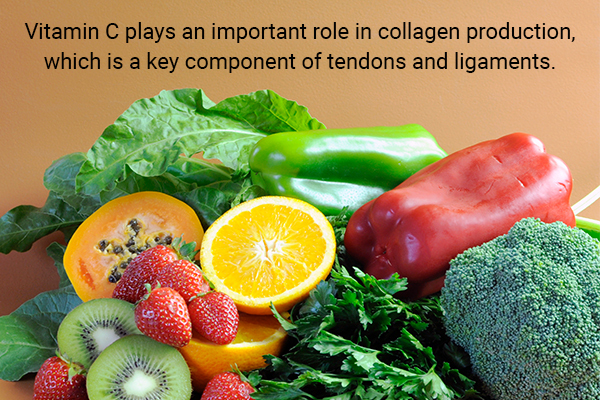
Vitamin C plays an important role in collagen production, which is a key component of tendons and ligaments.
By this logic, a vitamin C deficiency can slow down collagen synthesis in the body, thereby weakening our tendons and ligaments. Thus, consuming vitamin C-rich foods can prove effective in averting a case of tendinitis. (12)
Furthermore, it has been found that supplementing an intermittent exercise program with vitamin C-heavy gelatin facilitates collagen synthesis and could play a beneficial role in injury prevention and tissue repair. (13)(14)
Incorporating at least 90 milligrams of vitamin C daily can be beneficial in repairing a worn-out tendon. This is pretty easy to achieve with a diet rich in vegetables and fruits.
8. Dab castor oil
You can also try castor oil to ease the symptoms of Achilles tendinitis. The main component of castor oil is ricinoleic acid, which works as an anti-inflammatory agent.
According to a 2001 study published in Naunyn-Schmiedeberg’s Archives of Pharmacology, the ricinoleic acid in castor oil possesses capsaicin-like, dual pro-inflammatory and anti-inflammatory properties, which are observed upon acute and repeated application, respectively. (15)
How to use:
- Capitalize on castor oil’s therapeutic anti-inflammatory traits by applying it on the affected area repeatedly, such as two to three times a day.
- This will help relieve pain and minimize the inflammation of the tendon.
9. Up your vitamin E intake
Vitamin E is a fat-soluble antioxidant that helps relieve inflammation and pain by getting rid of free radicals that may be contributing to it. Vitamin E also improves circulatory function, which reduces swelling and promotes healing. (16)
- Use vitamin E oil to massage the affected area, two to three times a day until the pain is gone for good.
- Also, eat vitamin E-rich foods
- Another alternative is to include a vitamin E supplement in your diet but only after clearing it with your doctor.
10. Soak in Epsom salt water

Another effective remedy for Achilles tendinitis is an Epsom salt soak. The magnesium in Epsom salt promotes healing of sore and injured muscles. It also helps relax the muscles and reduce pain and swelling. (17)
How to use:
- Add a ½ cup of Epsom salt to a small tub filled with warm water.
- Stir the water well until the salt is dissolved.
- Soak the affected leg in this warm water for about 30 minutes.
- Repeat this soak two to three times a week for a few weeks.
11. Drink turmeric milk
Turmeric is another natural cure for Achilles tendinitis. The spice contains a chemical compound called curcumin that serves as an anti-inflammatory to effectively reduce pain and swelling in the calf. (18)(19)
How to use:
- Boil 1 teaspoon of turmeric powder in 1 cup of milk and let it simmer for 5 minutes. Add a little honey to it and drink this turmeric milk twice daily to promote healing.
- You can also take curcumin supplements, but only after consulting a doctor.
How Do You Prevent Achilles Tendinitis?
- A quick warmup preceding your daily exercise can go a long way in preventing a tendon injury. It helps to loosen up the body and allows the muscles time to adjust to the workout that lies ahead.
- Wear the right shoes. A healthcare professional such as a physical therapist can guide you in buying the best shoe for your specific foot structure. You want to make sure that your shoes keep your feet well cushioned and provide them the right blend of arch support and mobility. A cushioned heel insert for your shoe may also be of benefit.
- Don’t stick to the same exercise routine as it leads to repetitive strain to the same muscles and tendons, causing them to collapse.
- Don’t shock your body into a sudden spurt of activity. It is best to increase the intensity of your workout gradually if you want to avoid unnecessary straining of the muscles.
- By staying consistently active all year round, you condition your body to adapt to new movements and exercises with relative ease.
What Is the Difference Between Tendinosis and Tendinitis?
Tendinosis and tendinitis are both problems related to the tendons and are often used interchangeably but wrongly so. The former is an acute condition involving the degeneration of tendon tissue, while the latter is a chronic and long-term problem that involves the inflammation of the tendons.
Although inflammatory pain is largely associated with tendinitis, tendinosis may involve some degree of inflammation as well. Tendinosis brought on by the gradual wear and tear of your tendons is perhaps the most prevalent form of tendon disorder.
In order to distinguish between the two, your doctor may conduct an ultrasound or magnetic resonance imaging (MRI) of the affected area.
Additional Tips to Manage Achilles Tendinitis
- When suffering from Achilles tendinitis, rest your leg as much as possible. Avoid putting weight on your leg, which will delay healing.
- Keep the affected leg elevated to promote healing. Prop your leg up on a pillow when you are sitting or lying down.
- Take time to stretch your calf muscles and Achilles tendon in the morning, before exercise, and after exercise to prevent recurrence.
- Avoid wearing high heels, as it tends to increase your risk of developing Achilles tendinitis.
When to Consult a Doctor

If you suspect that your Achilles tendon has ruptured, you will require surgical intervention and therefore must consult your doctor at the earliest.
Expert Answers (Q&A)
Answered by Dr. Nirav Amin, MD (Orthopedic)
In general, through the literature Achilles tendinitis appears to improve with rest and physical therapy. In the past, I reviewed NBA players with Achilles tendinitis and noted a return to play was reasonable without any surgical treatment.
If the Achilles tendinitis is left untreated, the potential functional limitation can affect the gait patterns and other parts of the body. In addition, the activity levels of an individual may be decreased with the tendinitis which is not treated. The patient may experience worsened tendon inflammation, leading to a longer reversal of the tendon and recovery time.
Final Word
There is not a defined recovery period for Achilles tendinitis which could vary from weeks to months. It largely depends on how well the patient complies with physical therapy and adopts a focused approach to decrease the load of the tendons.
It is important to have a discussion with the patients about the expectations and the long recovery time ahead. It is important to explain the need to follow a physical therapy-based protocol and continue with home exercises to improve the functioning of the tendon.
- Was this article helpful?
- YES, THANKS!NOT REALLY


